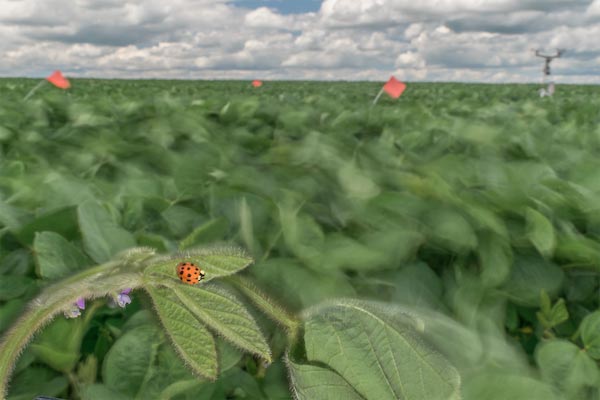Dwindling Wind May Tip Predator-Prey Balance

Brandon Barton An asian lady beetle rests on a plant in a soybean field in this time-exposure image. New research suggests that diminishing wind speeds caused by climate change affect the ability of such insects to capture prey.
Rising temperatures and shifting precipitation patterns may get the lion’s share of our climate change attention, but predators may want to give some thought to wind, according to a University of Wisconsin Madison zoologist’s study, which is among the first to demonstrate the way “global stilling” may alter predator-prey relationships.
“There are all sorts of other things that are changing in the environment that affect animals and plants and their interactions,” says Brandon Barton, a UW–Madison postdoctoral researcher. “My students and I were standing out in a cornfield one day as big gusts of wind came by, and the corn stalks were bending almost double. From the perspective of an animal living in the corn, we thought, ‘That’s got to have a big effect.’”
Wind speeds in the Midwest are expected to decline as much as 15 percent during the 21st century. Earth’s poles are warming faster than the equator, robbing the atmosphere of some of the temperature differential that creates wind. And the trend across the American landscape is to put up barriers to the wind in the form of buildings and more natural structures.
“In North America, we’ve been replanting trees that were lost in the 1800s, after settlers showed up and just leveled places like New England,” Barton says.
That’s good news for hungry lady beetles, according to research Barton published in the September issue of the journal Ecology.
Lady beetles eat a major soybean pest, the soybean aphid. Barton grew plots of soybeans in alfalfa fields, protecting some with wind blocks and leaving others in the open.
He found two-thirds more lady beetles in the plots hidden from the wind, and twice as many soybean aphids on the plants growing in the open.
Wind has no direct effect on the aphids, tiny insects that hug the plants and anchor themselves while feeding with a needle-like mouthpart called a stylet.
“The aphids appear on the plants whether it’s windy or not, and we showed that in lab experiments,” Barton says. “But when you add the predators, with the wind block, the beetles eat something like twice as many aphids.”
In his lab trials — simulating wind with fans and windless movement with a machine that tugged on tethered plants to shake and bend them — a stilled soybean plant represented a smorgasbord for the lady beetle.
“How do you do your duty as a predator if you’re entire world is moving around?” says Barton, whose work is funded by the National Science Foundation. “If the plant is moving, it takes four times as long for the predator to start eating, and it eats less than half as many aphids in an hour.”
Slower natural wind speeds could reduce the amount of pesticide required to keep soybean aphids from wrecking harvests. And the wind research may present other opportunities for pest control.
“By growing trees or not harvesting them around a field, you may be able to have an indirect effect on the number of aphids on your soybean plants,” says Barton, who wonders what other close animal relationships may be disrupted by shifting winds.
“The mechanism may be different for other predators, but it’s not hard to start thinking about effects,” he says. “Think of a wolf or coyote. Larger predators hunting by scent — and the prey trying to detect their predators — may be affected by less wind moving scents around.”
Contact Information
Brandon Barton, 608-262-9226, btbarton@wisc.edu
Media Contact
All latest news from the category: Ecology, The Environment and Conservation
This complex theme deals primarily with interactions between organisms and the environmental factors that impact them, but to a greater extent between individual inanimate environmental factors.
innovations-report offers informative reports and articles on topics such as climate protection, landscape conservation, ecological systems, wildlife and nature parks and ecosystem efficiency and balance.
Newest articles

Nerve cells of blind mice retain their visual function
Nerve cells in the retina were analysed at TU Wien (Vienna) using microelectrodes. They show astonishingly stable behavior – good news for retina implants. The retina is often referred to…

State-wide center for quantum science
Karlsruhe Institute of Technology joins IQST as a new partner. The mission of IQST is to further our understanding of nature and develop innovative technologies based on quantum science by…

Newly designed nanomaterial
…shows promise as antimicrobial agent. Rice scientists develop nanocrystals that kill bacteria under visible light. Newly developed halide perovskite nanocrystals (HPNCs) show potential as antimicrobial agents that are stable, effective…



